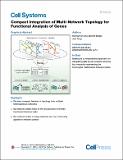| dc.contributor.author | Cho, Hyunghoon | |
| dc.contributor.author | Berger Leighton, Bonnie | |
| dc.contributor.author | Peng, Jian | |
| dc.date.accessioned | 2018-05-17T17:31:08Z | |
| dc.date.available | 2018-05-17T17:31:08Z | |
| dc.date.issued | 2016-11 | |
| dc.date.submitted | 2016-08 | |
| dc.identifier.issn | 2405-4712 | |
| dc.identifier.uri | http://hdl.handle.net/1721.1/115430 | |
| dc.description.abstract | The topological landscape of molecular or functional interaction networks provides a rich source of information for inferring functional patterns of genes or proteins. However, a pressing yet-unsolved challenge is how to combine multiple heterogeneous networks, each having different connectivity patterns, to achieve more accurate inference. Here, we describe the Mashup framework for scalable and robust network integration. In Mashup, the diffusion in each network is first analyzed to characterize the topological context of each node. Next, the high-dimensional topological patterns in individual networks are canonically represented using low-dimensional vectors, one per gene or protein. These vectors can then be plugged into off-the-shelf machine learning methods to derive functional insights about genes or proteins. We present tools based on Mashup that achieve state-of-the-art performance in three diverse functional inference tasks: protein function prediction, gene ontology reconstruction, and genetic interaction prediction. Mashup enables deeper insights into the struct ure of rapidly accumulating and diverse biological network data and can be broadly applied to other network science domains. Keywords: interactome analysis; network integration;
heterogeneous networks; dimensionality reduction; network diffusion;
gene function prediction; genetic interaction prediction; gene ontology reconstruction; drug response prediction | en_US |
| dc.description.sponsorship | National Institutes of Health (U.S.) (Grant R01GM081871) | en_US |
| dc.publisher | Elsevier BV | en_US |
| dc.relation.isversionof | http://dx.doi.org/10.1016/J.CELS.2016.10.017 | en_US |
| dc.rights | Creative Commons Attribution-NonCommercial-NoDerivs License | en_US |
| dc.rights.uri | http://creativecommons.org/licenses/by-nc-nd/4.0/ | en_US |
| dc.source | Elsevier | en_US |
| dc.title | Compact Integration of Multi-Network Topology for Functional Analysis of Genes | en_US |
| dc.type | Article | en_US |
| dc.identifier.citation | Cho, Hyunghoon et al. “Compact Integration of Multi-Network Topology for Functional Analysis of Genes.” Cell Systems 3, 6 (December 2016): 540–548 © 2016 The Authors | en_US |
| dc.contributor.department | Massachusetts Institute of Technology. Computer Science and Artificial Intelligence Laboratory | en_US |
| dc.contributor.department | Massachusetts Institute of Technology. Department of Mathematics | en_US |
| dc.contributor.mitauthor | Cho, Hyunghoon | |
| dc.contributor.mitauthor | Berger Leighton, Bonnie | |
| dc.contributor.mitauthor | Peng, Jian | |
| dc.relation.journal | Cell Systems | en_US |
| dc.eprint.version | Final published version | en_US |
| dc.type.uri | http://purl.org/eprint/type/JournalArticle | en_US |
| eprint.status | http://purl.org/eprint/status/PeerReviewed | en_US |
| dc.date.updated | 2018-05-16T16:39:19Z | |
| dspace.orderedauthors | Cho, Hyunghoon; Berger, Bonnie; Peng, Jian | en_US |
| dspace.embargo.terms | N | en_US |
| dc.identifier.orcid | https://orcid.org/0000-0002-2713-0150 | |
| dc.identifier.orcid | https://orcid.org/0000-0002-2724-7228 | |
| mit.license | PUBLISHER_CC | en_US |
